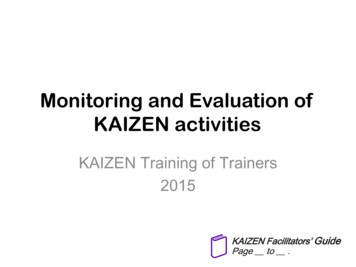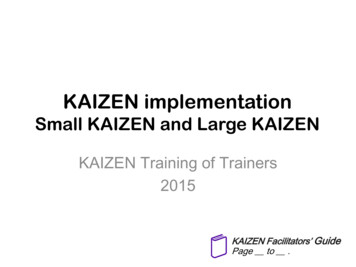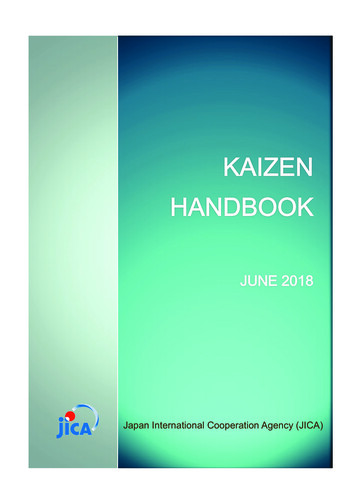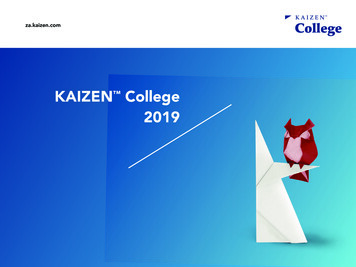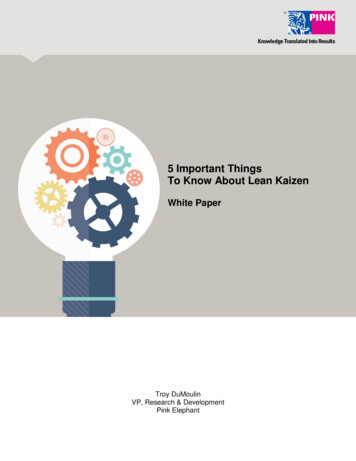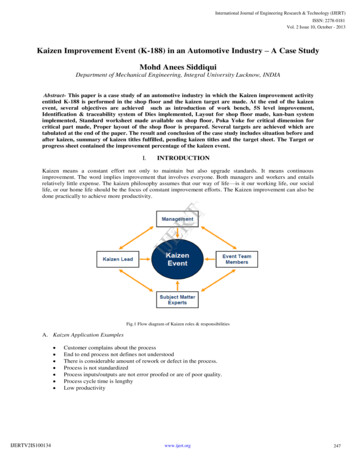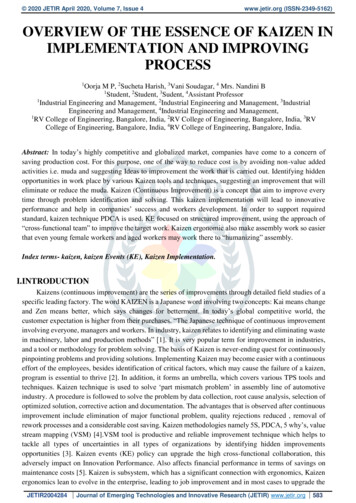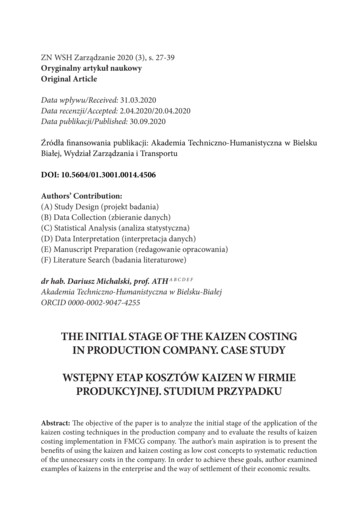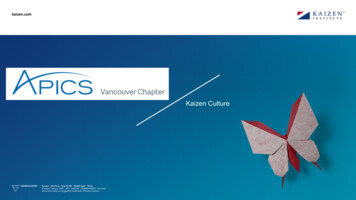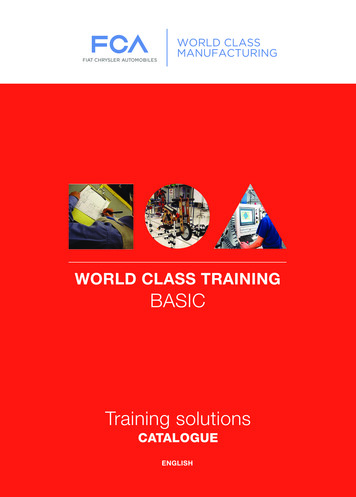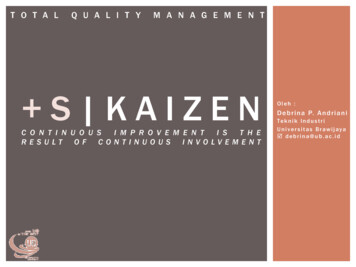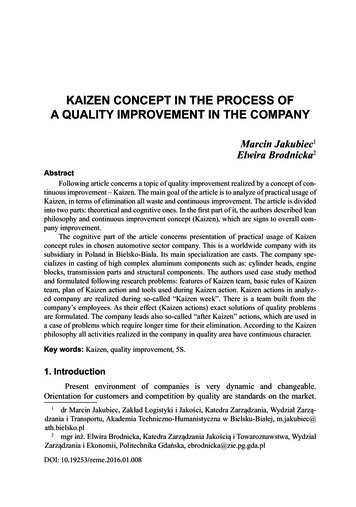
Transcription
KAIZEN CONCEPT IN THE PROCESS OFA QUALITY IMPROVEMENT IN THE COMPANYMarcin Jakubiec1Elwira Brodnicka2AbstractFollowing article concerns a topic of quality improvement realized by a concept of continuous improvement – Kaizen. The main goal of the article is to analyze of practical usage ofKaizen, in terms of elimination all waste and continuous improvement. The article is dividedinto two parts: theoretical and cognitive ones. In the first part of it, the authors described leanphilosophy and continuous improvement concept (Kaizen), which are signs to overall company improvement.The cognitive part of the article concerns presentation of practical usage of Kaizenconcept rules in chosen automotive sector company. This is a worldwide company with itssubsidiary in Poland in Bielsko-Biała. Its main specialization are casts. The company specializes in casting of high complex aluminum components such as: cylinder heads, engineblocks, transmission parts and structural components. The authors used case study methodand formulated following research problems: features of Kaizen team, basic rules of Kaizenteam, plan of Kaizen action and tools used during Kaizen action. Kaizen actions in analyzed company are realized during so-called “Kaizen week”. There is a team built from thecompany’s employees. As their effect (Kaizen actions) exact solutions of quality problemsare formulated. The company leads also so-called “after Kaizen” actions, which are used ina case of problems which require longer time for their elimination. According to the Kaizenphilosophy all activities realized in the company in quality area have continuous character.Key words: Kaizen, quality improvement, 5S.1. IntroductionPresent environment of companies is very dynamic and changeable.Orientation for customers and competition by quality are standards on the market.dr Marcin Jakubiec, Zakład Logistyki i Jakości, Katedra Zarządzania, Wydział Zarządzania i Transportu, Akademia Techniczno-Humanistyczna w Bielsku-Białej, m.jakubiec@ath.bielsko.pl2mgr inż. Elwira Brodnicka, Katedra Zarządzania Jakością i Towaroznawstwa, WydziałZarządzania i Ekonomii, Politechnika Gdańska, ebrodnicka@zie.pg.gda.pl1DOI: 10.19253/reme.2016.01.008
90Marcin Jakubiec, Elwira BrodnickaImprovement of quality (in wide meaning, quality of processes, products, work andso on) is a duty, not additional action taken by managers. Improvement must havecontinuous character. In a set of tools used to manage a quality, lean approach with itskey part Kaizen are useful instruments leading a company towards quality company.Following article concerns a topic of quality improvement realized by mentioned instruments: lean approach and Kaizen. The main goal of the article is to analyze of practical usage of Kaizen, in terms of elimination problems and continuousimprovement. The article is divided into two parts: theoretical and cognitive ones.In the first part of it, the authors described lean philosophy and continuous improvement concept (Kaizen), which are signs to overall company improvement. The cognitive part of the article concerns presentation of practical usage of Kaizen conceptrules in chosen automotive sector company. The authors used Case study methodand formulated following research problems: features of Kaizen team, basic rulesof Kaizen team, plan of Kaizen action and tools used during Kaizen action. Kaizenactions in analyzed company are realized during so-called “Kaizen week”. As theireffect exact solutions of quality problems are formulated.2. Improvement of quality management systems in a company– lean philosophyMore than sixty years ago first institutional systems of quality improvementin the sphere of organization management were implemented. The literature of thesubject (quality improvement) distinguishes levels of improvement which organization can achieve on the trajectory of improvement. Aiming to being an intelligentorganization, implementing solutions of management continuous improvement, canbe achieved by different levels (figure 1) (Lisiecka, 2009, pp. 24–25).Way to perfect organization goes through implementation of management systems according to ISO norm 9000, next implementation of TQM rules and preparing self-assessment report for quality awards. Next levels of improvement embraceLean Management concept, Reengineering, to intelligent and perfect organization.Continuous improvement of organization happens by every day effort and giving ofproofs of hiking on perfection tip, but also by effort connected with breakthrough inbusiness about strategic character (Lisiecka, 2009, pp. 25–26).One of a way of organization improvement is a lean approach and its key partKaizen concept. Almost thirty years ago the lean approach was relatively radical,even for large and sophisticated companies. Now the lean is being adopted outsideit traditional automotive, high-volume and manufacturing roots. But wherever it isapplied, the principles remain the same. The key principle of lean operations meansmoving towards the elimination all waste in order to develop an operation that isfaster, more dependable, produces higher-quality products and services and, aboveall, operates at low cost.
Kaizen concept in the process of a quality improvement in the company91Intelligent OrganizationContinuous Improvement, Benchmarking,Reengineering, Lean Management, OutsourcingTQM, Polish Quality Award, European Quality Award,Awards: Deming and BaldrigeManagement Integrated SystemsNormalization the ISO 9000 family of standardsPerfect OrganizationFig. 1. Levels of organization improvementSource: K. Lisiecka (2009, p. 27).The lean approach to managing operations is founded on doing the simplethings well, on gradually doing them better and, above all, on squeezing out wasteevery step of the way. Often seen as the practitioner of the lean approach in Japan,the Toyota Motor Company has developed a set of practices which has shaped whatwe call lean. Three key issues define the lean philosophy: the elimination of waste,the involvement of staff in the operation and drive for continuous improvement –Kaizen (figure 2) (Slack et al., 2007, pp. 466–469).Fig. 2. The lean philosophy of operationsSource: N. Slack, S. Chambers, R. Johnston (2007, p. 469).
92Marcin Jakubiec, Elwira BrodnickaThe most significant part of the lean philosophy is focused on the eliminationall forms of waste. Waste can be defined as any activity which does not add value. Twosimple devices are commonly used in lean improvement (Slack et al., 2007, p. 470):1. One “the seven forms of waste” is concerned with identifying waste as the firststep towards eliminating it.Toyota has identified seven types of waste (Japanese Muda), which have beenfound to apply in many different types of operations (service and production)and which form the core of lean philosophy: over-production, waiting time,transport, process, inventory, motion and defectives (table 1).Table 1. Types of MudaWasteDescriptionOver-productionproducing more than client needs (frozen capital, used energy,warehousing expenses); also too much informationInventorythey are result of overproduction, accumulate space, create necessityof transportationMotionwalking, bending, taking, etc.; unnecessary moves make longer production process and negatively affect on safety and health of employeesTransporttransport of products in the progress, semi-products, finished products(trolleys) — causes costs and longer processesProcessplanning of production process in such a way, that it imposes additionalunnecessary activities, what causes extra costs and longer processesDefectivesproduction and making of deficiencies, organizing post for deficienciesrepairingWaiting timewaiting of operator for machine, employee for instruction, employeefor decision, machine for repairing, etc.Source: K. Kobyłecka (2007, pp. 47–49).2. “The 5S’s” is a simple set of principles for reducing waste”: sort – eliminate what is not needed and keep what is needed; straighten – position things in such a way that they can be easily reachedwhenever they are needed; shine – keep things clean and tidy; no refuse or dirt in work area; standardize – maintain cleanliness and order; sustain – develop a commitment and pride in keeping to standards.The 5S’s can be thought of as a simple housekeeping methodology to organizework areas that focuses on visual order, organization, cleanliness and standardization. It helps to eliminate all types of waste relating to uncertainty, waiting, searching for relevant information, creating variation and so on. By eliminating what
Kaizen concept in the process of a quality improvement in the company93is unnecessary and making everything clear and predictable, clutter is reduced,needed items are always in the same place and work is made easier and faster.The most typical and relevant features of lean management are (Grudzewski,Hejduk, 2004, p. 201):—— integration of all strategic and operational actions taken by a company (organizational, economic, technical, social, and so on);—— decentralization of management on all basic levels of a company;—— optimization of manufacturing, supporting and service processes;—— implementation of restructured, modernized and developing activities;—— usage of total quality management system;—— stimulation of employees’ motivation to good and free of waste work;—— free from bureaucracy of management activity;—— direct contacts of a company with suppliers, cooperators, customers and so on.Lean management is one of a few ways which a company could go towards improvement of quality.3. Kaizen – a way to improvement of qualityKaizen means continuous process of improvement which engages top management of a company, management staff and all employees. It requires relevantchanges in people’s behavior and authority based on experience, authority of leader.Kaizen is based on assumption that all employees possess skills which can be usedin a better way (Frąś, 2013, p. 264).A word of “kaizen” is a combination of two Japanese words: kai – “change”and zen – “good”. In this translation Kaizen means a change for a good. Accordingto a literature Kaizen is defined as:—— step-by-step, ordered and continuous improvement, improvement of value(Pieczonka, Tabor, 2003, p. 86);—— it means improvement. Moreover, it means continuous improvement in personallife, on social and work platform. In a company Kaizen is permanent improvement of all – managers and employees (Imai, 2007, p. 18).A big meaning for growth of this philosophy has had enlargement of TotalQuality Management concept, in which originally Kaizen was an element of improvement characteristic for Japanese techniques of quality management, e.g. zerodefects, Deming Cycle, quality circles, prevention system, Just-in-Time and so on.This approach meant that everything could be done better, that thanks to small stepsplanned effects could be achieved. Improvement concerns everything, it should berealized every day, by everybody, from small improvements to big strategic changes.Kaizen induces employees to improve their work stand, to bigger independence andself-control. Fundamental goals of Kaizen concern improvement of: quality, cost and
94Marcin Jakubiec, Elwira Brodnickatime of delivery. It means change of products’ quality, processes, lower costs andshorter time of order realization (Skrzypek, 2014, pp. 90–91).Improvements can be divided into two groups: innovation and Kaizen.Innovation, which is a domain of western companies, is perceived as a changecaused by breakthrough in technique discipline, implementation of the newest management concepts and manufacturing techniques. It has rather revolution character.Sometimes, innovation is defined as an idea, behavior quality different thing from sofar existing, and its typical feature is this, that after its implementation time of discipline collapse happens, positive effects of innovation have a tendency to disappear.Kaizen is small improvement, but permanent, with determination and consequence. Improvements have gentle character. A characteristic feature of this approachis this, that it does not need complicated techniques or the newest technologies. Thiswhat is needed it is conventional techniques (e.g. Pareto diagram, Ishikawa diagram,control cards) and common sense. Table 2 shows differences between Kaizen andinnovation.Table 2. Kaizen versus innovationCriteriaKaizenInnovationEffectLong-term, not breakthroughShort-term, breakthroughStepsSmall stepsBig stepsTime frameworkPermanent action withgradually rising effectsIncidental action with immediateeffectChangeGradual and permanentSudden and singleEngagementAllChosen “leaders”ApproachTeam effort, process approachIndividual ideas and actionsWork methodMaintenance and improvement “Extinguishing” and rebuildIdeasConventional know-howand traditional technologyUsage of technologicalbreakthrough, new inventionsand theoriesPractical requirementsSmall investments, big effortBig investments, small effortOrientationFor peopleFor technologyAssessment criteriaProcess and engagementin achieving of better resultsResults directly affect on profitsUsageIt exists well in stabledeveloping economyIt exists better in quicklydeveloping economySource: M. Imai (2007, p. 54).
95Kaizen concept in the process of a quality improvement in the companyThe best solution is a combination of Kaizen and innovation. Maintenance ofinnovation results requires effort, without it results of innovation disappear. Kaizenprotects from degradation, but also slowly rises standard, treating it as a base to improving process (figures 3) (Frąś, 2013, p. 266).InnovationTimeDesirable situationReal situationInnovationTimeKaizenNew standardFig. 3. Implementation of innovation without (a) and with (b) KaizenSource: J. Frąś (2013, p. 266).Fundamental rules of Kaizen are as follows (Frąś, 2013, p. 267):—— philosophy – prevention instead of detection,—— procedure – total quality management,—— scale – everybody is responsible for quality,—— measure – quality costs,—— norm – properly for the first time,—— scope – a whole organization,—— topic – continuous improvement.Kaizen is a continuous process, including all people in organization, everymanager and every employee is engaged in its aspects. Kaizen requires a mission,
96Marcin Jakubiec, Elwira Brodnickachanges in people’s behavior, dialogue between managers and employees and orientation on quality process. In assessment of Kaizen important is not only effect ofevery action, by effort taken for its realization, every employee tries to work as goodas possible.4. Kaizen in practice – analysis of quality improvement based onchosen automotive companyIn this part of the article use of Kaizen in practice (its rules) was presented.The analysis is based on case study method, made in chosen automotive sector company. Other details of analysis presents table 3.Table 3. Characteristic of made analysisAssumptionsDescriptionPurpose of researchanalysis of practical usage of Kaizen, in terms ofelimination of problems and continuous improvementResearch problems Research methodcase study methodAnalyzed companycompany from automotive sector, specialized in castingof different parts of carsfeatures of Kaizen team,basic rules of Kaizen team,plan of Kaizen action,tools used during Kaizen actionSource: Personal elaboration.The analyzed company, as it was mentioned, represents automotive sector.This is the worldwide company with its subsidiary in Poland in Bielsko-Biała. Itsmain specialization are casts. The company specializes in casting of high complexaluminum components such as: cylinder heads, engine blocks, transmission partsand structural components. In company following managements systems: ISO/TS16949, ISO 14001, OHSAS 18001 are implemented.The company uses in every day practice Kaizen concept and its rules andtools. According to representatives of management of the company Kaizen is: “lowcosts, common sense and creative approach to improvement. Kaizen essence aresmall changes which could minimize losses. The biggest amount of such ideas arecreated on the lowest level of organization structure”.In analyzed company in the framework of Kaizen are organized so called“weeks with Kaizen”.
Kaizen concept in the process of a quality improvement in the company97Monday―――training and problem analysis,visit of analyzed places,made a list of ideasTuesday― proposals and planning of workWednesday― work on analyzed places – new ideas,― implementation of ideasThursday― work on analyzed places –implementation of ideas – continuationFriday― verification of achieved resultsand presentation of team resultsto managementFig. 4. Plan of “Kaizen week”Source: Personal elaboration based on information of analyzed company.These are groups of employees (8–12 persons) delegated to exact actions,excluded from daily duties. During such workshop employees work over solutionsof selected problems, with use of Kaizen tools. For example: brain storm, Ishikawadiagram or 5S tool. The purpose of “week with Kaizen” is to create and implementvisible improvements in exact area of a company (often in exact processes).Features of Kaizen team are as follows:—— members of different departments,—— excluded from daily duties,—— persons out of workshop cannot interfere in project preparation.
98Marcin Jakubiec, Elwira BrodnickaDuring Kaizen action members of a team obey following rules:—— open for changes and new ideas,—— positive attitude,—— fight with stereotypes,—— conviction to right of work,—— respect of team members,—— one person, one voice,—— searching for solutions not problems,—— searching for simple solutions.In the second quarter of 2014 team of Kaizen worked over implementationof 4S tool in exact places of analyzed company: weld room, warehouse of parts tocranes and ironworks. In workshop took part eight employees who constituted mentioned goal about implementation. Plan of week presents figure 4.During the first day of work the team started observation in analyzed places.The amount of suggested ideas was 128. After strong discussion and classification ofideas stayed 76 ideas, some of them were repeated, a few members perceived similarproblems. The team decided to implement 53 ideas. The main criterion to chooseideas was reality of implementation. For them matrix of influences and difficultieswas prepared (figure 5). 345Influences12345––9Difficulties Fig. 5. Matrix of influences and difficultiesSource: Personal elaboration based on information of analyzed company.The table 4 shows perceived chosen problems and ways of their improvement.Examples of problems mentioned in the table 4 perceived and repaired during Kaizenprocess are only small percent of total amount of malfunctions defined by Kaizenteam. Only in this selected places of analysis the team was able to perceive morethan fifty problems chosen to improvement. It shows that scale of areas and problems to improvement in companies and organizations is really big.
Kaizen concept in the process of a quality improvement in the company99Table 4. Problems identified during Kaizen processProblemsImprovementslack of descriptions on containersrealized proper descriptionsold door to warehouse of cranesrestored doorold switching stationrestored substationlack of marking of doorstep of enteringdoor to warehouse of cranespainted doorsteplack of space for spare partsmade standlack of space for weldersdesignated and described proper spacefor welderslack of designated space for used partsdesignated place and prepared descriptionsold and dusted instructionsprepared new onespoor light in weld roomrealized new, better lightold burnt sheet metals on a desk to gas cuttingrealized new sheet metalsSource: Personal elaboration based on information of analyzed company.At the end of Kaizen action the team prepares a presentation showing a wholeweek of work, amount of problems and ideas (solutions) identified by the team. Theteam presents implemented solutions and first results of improvements. In analyzedcompany after Kaizen action is realized so called “after Kaizen” period. Some ofidentified problems could be solved immediately, during Kaizen week, but some ofthem requires longer action. This is “after Kaizen” time. Designated person (usuallya member of Kaizen team) is responsible for implementation of defined solutionsand prepares at the end of all actions a report documenting achieved results.5. ConclusionsThere is no better way than Kaizen to reflect organization culture gearedtowards improvement realizes by minor steps, step by step, every day, within theframework of all processes. Kaizen derives from Japan and means gradual, systematic and continuous improvement. This concept pulls in all employees in improvement process. Kaizen concentrates on elimination of all defects, losses in all systemsand processes. Every employee is obliged to improve his/her individual skills inorder to be able to achieve high quality, low costs and deliveries on time. Kaizen isnot based on modern technologies, revolutionary and expensive investments, but onsuccess achieving by steady minor changes. Thanks to Kaizen changes and success-
100Marcin Jakubiec, Elwira Brodnickaes come out not from total company reorganization or crucial investments, but fromsynergy effect — minor transformations. Kaizen means permanent improvement implementing by small changes without critical interference, different to innovation,which radically changes status quo (Łuczak, Flejszman-Matuszak, 2007, p. 375). Itmeans also improvement in personal life, home life, social life and work life. Whenapplied to the work place, Kaizen means continuing improvement involving everyone – managers and workers alike (Slack et al., 2007, p. 595).The example analyzed in the cognitive part of the article confirms a big meaning of Kaizen in the process of continuous improvement. A set of tools attributed tothis concept, such as: brain storm, Ishikawa diagram, matrix diagram, 5S tool, andothers, help to identify problems (causes of problems) and suggest possible waysof their elimination. Continuous improvement means also permanent prevention.Actions taken by a company to prevent before similar problems in the future. J. W.Goethe said: “A perfection is a measure of the sky, an aspiration to a perfection is ameasure of a men”. In a company, a success in the field of continuous improvementis dependent on employees, because they create a quality culture.References1. Barcik A., Jakubiec M. (ed.) (2014): Wybrane problemy zarządzania – ujęcie jakościowe,innowacyjne i konkurencyjne, Bielsko-Biała: Wyd. Naukowe Akademii Techniczno-Humanistycznej w Bielsku-Białej.Frąś J. (2013): Kompleksowe zarządzanie jakością w logistyce, Poznań: Wyd. Wyższej SzkołyLogistyki w Poznaniu.3. Grudzewski M., Hejduk I. (2004): Metody projektowania systemów zarządzania, Warszawa: Difin.4. Imai M. (2007): Kaizen – klucz do konkurencyjnego sukcesu Japonii, Warszawa: Wyd. MT Biznes.5. Jakubiec M., Kurowska-Pysz J. (2013): Jakość kształcenia zawodowego na pograniczu polsko-czeskim jako determinanta konkurencyjności przedsiębiorstw, Bielsko-Biała: Wyd. NaukoweAkademii Techniczno-Humanistycznej w Bielsku-Białej.6. Kobyłecka K. (2007): Jakość po japońsku, „Ogólnopolski Przegląd Medyczny” 5/2007.7. Lisiecka K. (2009): Systemy zarządzania jakością produktów. Metody analizy i oceny, Katowice:Wyd. Akademii Ekonomicznej w Katowicach.8. Łuczak J., Flejszman-Matuszak A. (2007): Metody i techniki zarządzania jakością. Kompendiumwiedzy, Poznań: Quality Progress.9. Pieczonka A., Tabor A. (2003): Vademecum jakości, Kraków: Wyd. Centrum Szkolenia i Organizacji Systemów Jakości Politechniki Krakowskiej.10. Skrzypek E. (ed.) (2014): Zasoby ludzkie a sukces organizacji w nowej gospodarce, Lublin: Wyd.UMCS.11. Slack N., Chambers S., Johnston R. (2007): Operations management, London: Prentice Hall Financial Times.2.ZASTOSOWANIE KONCEPCJI KAIZENW PROCESIE DOSKONALENIA JAKOŚCI W PRZEDSIĘBIORSTWIEStreszczenieArtykuł dotyczy tematyki doskonalenia jakości, które może być realizowane w przedsiębiorstwie za pomocą koncepcji ciągłego doskonalenia Kaizen. Główny cel artykułu kon-
Kaizen concept in the process of a quality improvement in the company101centruje się na analizie praktycznego zastosowania koncepcji Kaizen w celu eliminacji marnotrawstwa i ciągłego doskonalenia obszarów działalności przedsiębiorstwa. Rozdział zostałpodzielony na dwie części: teoretyczną i poznawczą. W pierwszej, teoretycznej części, autorzy opisali filozofię lean z jej kluczową częścią – koncepcją ciągłego doskonalenia Kaizen,będących znakami do doskonalenia przedsiębiorstwa.Poznawcza część artykułu dotyczy przedstawienia praktycznego zastosowania zasad koncepcji Kaizen w wybranym przedsiębiorstwie branży motoryzacyjnej. Jest to międzynarodowe przedsiębiorstwo z zakładem produkcyjnym w Polsce, w Bielsku-Białej.Przedsiębiorstwo to specjalizuje się w odlewach aluminiowych części silników, jak: cylindry, bloki silnika oraz części skrzyń biegów, dla światowych producentów samochodów.Jako metodę badawczą, autorzy zastosowali metodę analizy przypadku (case study) orazsformułowali obszary badawcze, tj.: cechy zespołu Kaizen, zasady zespołu Kaizen, plandziałań Kaizen oraz narzędzia stosowane w ramach tych działań. Działania Kaizen w analizowanym przedsiębiorstwie mają charakter tzw. „tygodnia z Kaizen” i są realizowane przezzespół pracowników, wyłączonych na ten czas ze swoich codziennych obowiązków. Efektemich pracy są propozycje usprawnień w analizowanych obszarach. Działania Kaizen obejmujątakże tzw. czas „after Kaizen”, kiedy dane rozwiązanie wymaga dłuższego czasu implementacji. Zgodnie z filozofią Kaizen wszystkie działania podejmowane w przedsiębiorstwie mającharakter ciągły.Słowa kluczowe: Kaizen, doskonalenie jakości, 5S.
Way to perfect organization goes through implementation of management sys-tems according to ISO norm 9000, next implementation of TQM rules and prepar- . Kaizen - a way to improvement of quality Kaizen means continuous process of improvement which engages top man-agement of a company, management staff and all employees. It requires relevant
